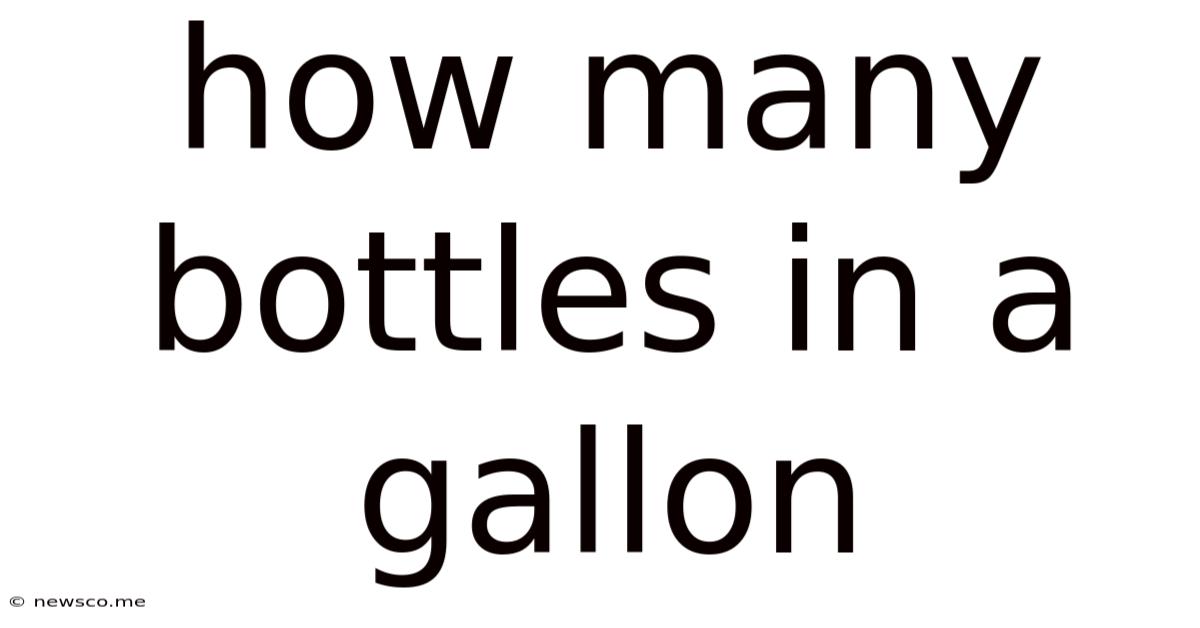How Many Bottles In A Gallon
News Co
Apr 23, 2025 · 5 min read

Table of Contents
How Many Bottles in a Gallon? A Comprehensive Guide to Volume Conversions
Understanding volume conversions is crucial in various aspects of life, from cooking and baking to industrial applications and even everyday tasks. One common question revolves around the seemingly simple conversion: how many bottles in a gallon? The answer, however, isn't straightforward, as it heavily depends on the size of the bottle. This comprehensive guide will delve into this query, exploring different bottle sizes, providing conversion formulas, and offering practical applications of this knowledge.
Understanding Gallons and Bottles: A Foundation for Conversions
Before diving into specific conversions, let's clarify the units involved:
-
Gallon (gal): A unit of volume in the US customary and imperial systems. There are variations – the US liquid gallon and the imperial gallon – with slightly different volumes. For simplicity, we'll primarily focus on the US liquid gallon, which is approximately 3.785 liters.
-
Bottle: This term is highly ambiguous. A bottle can range in size from a tiny medicine vial to a large wine bottle or a jug. Therefore, to accurately determine the number of bottles in a gallon, we need to know the volume of the bottle in a compatible unit (e.g., ounces, milliliters, or liters).
Calculating the Number of Bottles in a Gallon: A Step-by-Step Approach
The core principle behind the conversion is simple: divide the volume of a gallon by the volume of a single bottle. Here's a breakdown of the process:
-
Determine the bottle's volume: This is the most critical step. Check the bottle's label for its volume, usually expressed in fluid ounces (fl oz), milliliters (mL), or liters (L).
-
Convert units to a common base: If the bottle's volume is not in the same units as the gallon (US liquid gallon), perform the necessary unit conversion. Useful conversion factors include:
- 1 US liquid gallon = 128 fluid ounces (fl oz)
- 1 fluid ounce ≈ 29.57 milliliters (mL)
- 1 liter (L) = 1000 milliliters (mL)
-
Perform the division: Divide the volume of a gallon (128 fl oz or 3785 mL) by the volume of a single bottle (in the same units). This calculation will give you the number of bottles needed to fill a gallon.
Example: Let's say you have a bottle with a volume of 16 fluid ounces.
- Number of bottles = (128 fl oz/gallon) / (16 fl oz/bottle) = 8 bottles
Therefore, eight 16-ounce bottles would fill a gallon.
Practical Applications of Gallon-to-Bottle Conversions
The ability to convert between gallons and bottles finds practical application in many scenarios:
-
Cooking and Baking: Many recipes call for specific quantities of liquids, often expressed in cups or gallons. Knowing the volume of your bottles helps you measure accurately.
-
Home Improvement: When buying paint, cleaning supplies, or other liquids sold in gallons, understanding how many smaller bottles you'll need for storage or transport is essential.
-
Industrial Processes: Large-scale manufacturing and chemical processing often involve handling vast quantities of liquids. Precise volume conversions ensure efficient operations.
-
Inventory Management: Businesses that store or sell liquids need accurate volume conversions to track inventory and manage stock effectively.
Common Bottle Sizes and Their Equivalent in Gallons
Let's explore some common bottle sizes and their corresponding number in a gallon:
| Bottle Size (fl oz) | Bottles per Gallon |
|---|---|
| 16 fl oz | 8 |
| 12 fl oz | ~10.67 |
| 8 fl oz | 16 |
| 4 fl oz | 32 |
| 1 fl oz | 128 |
Note: These are approximate values. Slight variations may occur due to rounding and the specific dimensions of the bottles.
Beyond Standard Bottles: Irregular Shapes and Volume Measurement
Not all bottles are perfectly cylindrical or rectangular. Irregular shapes make volume calculations more challenging. In such cases, you might need to:
- Measure the bottle's volume directly: Using a graduated cylinder or other measuring device to determine the precise volume.
- Use water displacement: Fill a larger container with a known volume of water, submerge the bottle completely, and measure the increase in water level. The difference in water level represents the bottle's volume.
Advanced Conversions: Dealing with Imperial Gallons and Metric Units
While we've primarily focused on the US liquid gallon, it's essential to acknowledge the imperial gallon. The imperial gallon is larger than the US liquid gallon:
- 1 US liquid gallon ≈ 0.833 imperial gallons
- 1 imperial gallon ≈ 1.201 US liquid gallons
Therefore, conversions involving imperial gallons require a different set of conversion factors. Similarly, converting between gallons and metric units (liters, milliliters) necessitates using appropriate conversion factors. Remember to always use consistent units throughout your calculations to avoid errors.
Troubleshooting Common Conversion Mistakes
Several common pitfalls can lead to inaccurate results:
- Ignoring unit consistency: Failing to convert all measurements to the same unit before calculation is a frequent error.
- Using incorrect conversion factors: Ensure you're using the correct conversion factors for the units involved (e.g., US liquid gallon vs. imperial gallon).
- Rounding errors: Excessive rounding during intermediate calculations can lead to inaccuracies in the final result. Try to minimize rounding until the final answer.
Conclusion: Mastering Gallon-to-Bottle Conversions
Mastering the conversion between gallons and bottles is a valuable skill with wide-ranging practical applications. By understanding the fundamental principles, performing accurate calculations, and being aware of potential pitfalls, you can confidently navigate volume conversions in various contexts. Remember to always double-check your work and use appropriate conversion factors to ensure accurate results. With practice, you'll become proficient at this essential skill.
Latest Posts
Related Post
Thank you for visiting our website which covers about How Many Bottles In A Gallon . We hope the information provided has been useful to you. Feel free to contact us if you have any questions or need further assistance. See you next time and don't miss to bookmark.